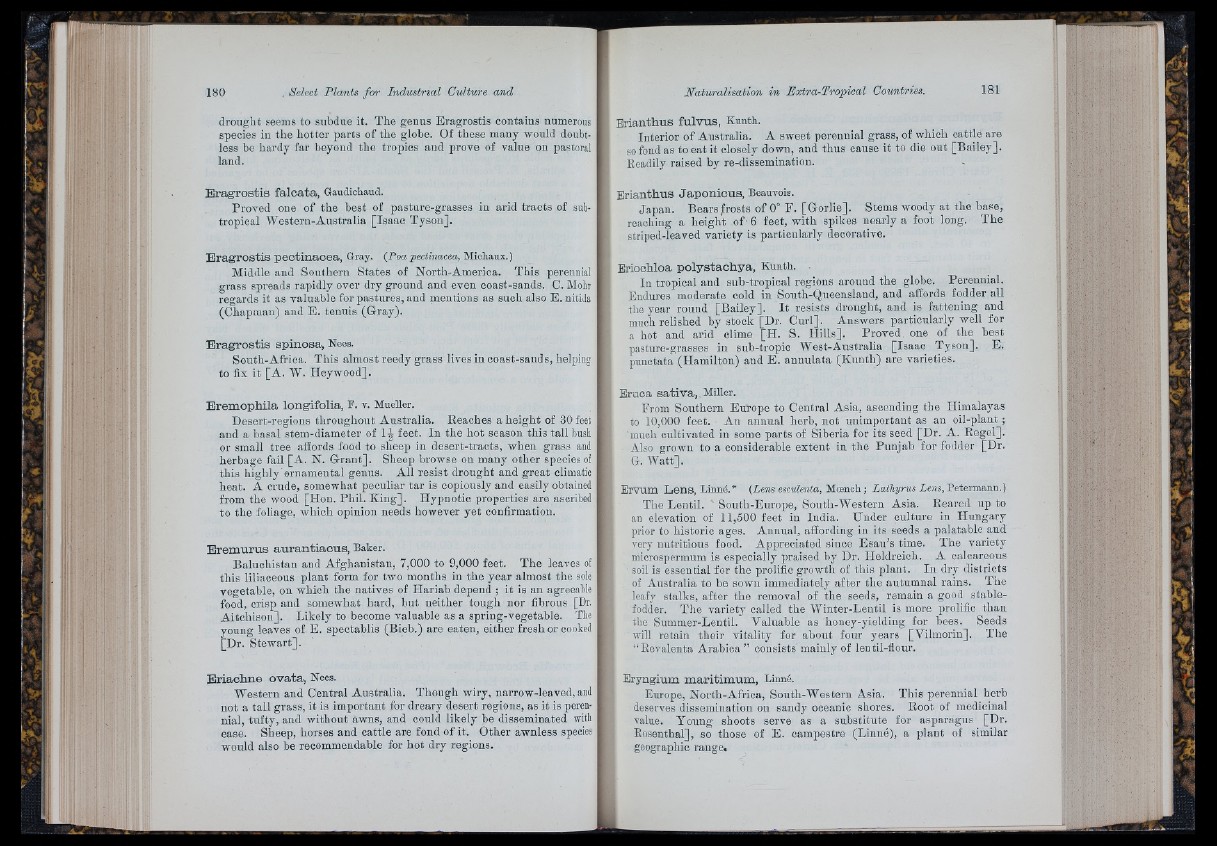
£ if
■I I ' '.;i
II •- JI i■j! '.
fr
i !:
i'i
s
, ■Í!i :;ii i;
drought seems to subdue it. The genus Eragrostis contains numerous
species in the hotter parts of the globe. Of these many would doubtless
be hardy far beyond the tropics and prove of value on pastoral
land.
E r a g r o s t i s f a lc a t a , Gaudichaud.
Proved one of the best of pasture-grasses in arid tracts of subtropical
Western-Australia [Isaac Tyson],
E r a g r o s t i s p e c t in a c e a , Gray. (Poa pectinacea, Michaux.)
Middle and Southern States of North-America. This perennial
grass spreads rapidly over dry ground and even ooast-sands. C. Mohr
regards it as valuable for pastures, and mentions as such also E. nitida
(Chapman) aud E . tenuis (Gray).
E r a g r o s t i s s p in o s a , Nees.
South-Africa. This almost reedy grass lives in coast-sands, helping
to fix it [A. W. Heywood].
E r em o p h i la lo n g ifo lia , F. v. Mueller.
Desert-regions throughout Australia. Reaches a height of 30 feet
and a basal stem-diameter of 1^ feet. In the hot season this tall bush
or small tree affords food to sheep in desert-tracts, when grass and
herbage fail [A. N. Gran t]. Sheep browse on many other species of
this highly ornamental genus. All resist drought aud great climatic
heat. A crude, somewhat peculiar ta r is copiously and easily obtained
from the wood [Hon. Phil. K in g ]. Hypnotic properties are ascribed
to the foliage, which opinion needs however yet confirmation.
E r e m u r u s a u r a n t i a c u s , Baker.
Baluchistan and Afghanistan, 7,000 to 9,000 feet. The leaves of
this liliaceous plant form for two months in the year almost the sole
vegetable, on which the natives of Hariab depend ; it is an agreeable
food, crisp and somewhat hard, but neither tough nor fibrous [Dr.
Aitchison]. Likely to become valuable as a spring-vegetable. The
young leaves of E. spectablis (Bieb.) are eaten, either fresh or cooked
[Dr. Stewart].
E r i a c h n e o v a ta , Nees.
Western and Central Australia. Though wiry, narrow-leaved, and
not a tall grass, it is important for dreary desert regions, as it is perennial,
tufty, and without awns, and could likely be disseminated with
ease. Sheep, horses and cattle are fond of it. Other awnless species
would also be reeommendable for hot dry regions.
MU
B r ia n th u s f u lv u s , Kunth.
Interior of Australia. A sweet perennial grass, of which cattle are
so fond as to eat it closely down, aud thus cause it to die out [Bailey].
Readily raised by re-dissemination.
B r ia n th u s J a p o n io u s , Beauvois.
Japan. Bearsfrosts of 0° F. [Gorlie]. Stems woody at the base,
reaching a height of - 6 feet, with spikes nearly a foot long. The
striped-leaved variety is particularly decorative.
Brioohloa p o ly s t a o h y a , Kunth.
In tropical and snb-tropical regions around the globe. Perennial.
Endures moderate cold in South-Queensiand, and affords fodder all
the year round [Bailey]. I t resists drought, and is fattening and
much relished by stock [Dr. C u rl]. Answers particularly well for
a hot and arid clime [H . S. Hills]. Proved one of the best
pasture-grasses in sub-tropic West-Australia [Isaac Tyson]. E.
punctata (Hamilton) and E . annulata (Kunth) are varieties.
Bruoa s a t iv a , Miller.
From Southern Europe to Central Asia, ascending the Himalayas
to 10,000 feet. An annual herb, not unimportant as an oil-plant ;
much cultivated in some parts of Siberia for its seed [Dr. A. Regel].
Also grown to a considerable extent in the Punjab for fodder [Dr.
G. Watt].
B rvum L e n s , Linné.* (Lens esculenta, Mam.ah.; Lathyrus Lens,'Petermarm.)
The Lentil. Sonth-Europe, South-W'esteni Asia. Reared up to
an elevation of 11,500 feet in India. Under culture in Hungary
prior to historic ages. Annual, affording in its seeds a palatable and
very nutritions food. Appreciated since Esau’s time. The variety
microspermum is especially praised by Dr. Heldreich. A calcareous
soil is essential for the prolific growth of this plant. In dry districts
of Australia to be sown immediately after the autumnal rains. The
leafy stalks, after the removal of the seeds, remain a good stable-
fodder. The variety called the Winter-Lentil is more prolific than
the Snmmer-Lentii. Valuable as honey-yielding for bees. Seeds
will retain their vitality for about four years [Vilmorin]. The
“ Revalenta Arabica ” consists mainly of lentil-flour.
Eryngium maritimum, Linné.
Europe, North-Africa, South-Western Asia. This perennial herb
deserves dissémination on sandy oceanic shores. Root of medioinal
value. Young shoots serve as a substitute for asparagus [Dr.
Rosenthal], so those of E. campestre (Linné), a plant of similar
geographic range.
fr.'
■iUUfr';
I M U . I U
J ÎM ,U 'U